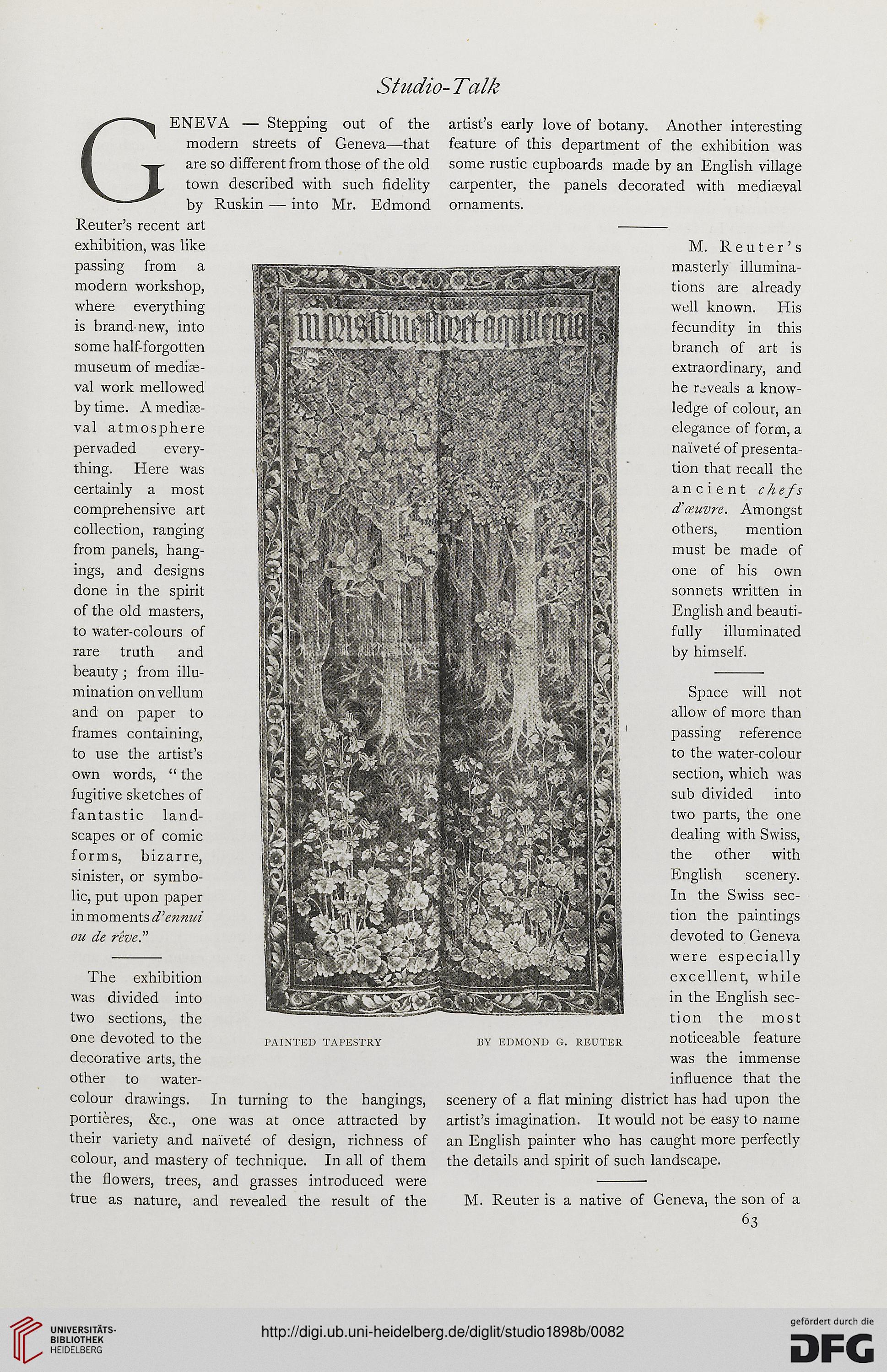Studio-Talk
The exhibition
was divided into
two sections, the
one devoted to the tainted tapestry
decorative arts, the
other to water-
colour drawings. In turning to the hangings,
portieres, &c., one was at once attracted by
their variety and naivete of design, richness of
colour, and mastery of technique. In all of them
the flowers, trees, and grasses introduced were
true as nature, and revealed the result of the
Space will not
allow of more than
passing reference
to the water-colour
section, which was
sub divided into
two parts, the one
dealing with Swiss,
the other with
English scenery.
In the Swiss sec-
tion the paintings
devoted to Geneva
were especially
excellent, while
in the English sec-
tion the most
by edmond g. reuter noticeable feature
was the immense
influence that the
scenery of a flat mining district has had upon the
artist’s imagination. It would not be easy to name
an English painter who has caught more perfectly
the details and spirit of such landscape.
GENEVA — Stepping out of the
modern streets of Geneva—that
are so different from those of the old
town described with such fidelity
by Ruskin — into Mr. Edmond
Reuter’s recent art
exhibition, was like
passing from a
modern workshop,
where everything
is brand-new, into
some half-forgotten
museum of mediae-
val work mellowed
by time. A mediae-
val atmosphere
pervaded every-
thing. Here was
certainly a most
comprehensive art
collection, ranging
from panels, hang-
ings, and designs
done in the spirit
of the old masters,
to water-colours of
rare truth and
beauty; from illu-
mination on vellum
and on paper to
frames containing,
to use the artist’s
own words, “ the
fugitive sketches of
fantastic land-
scapes or of comic
forms, bizarre,
sinister, or symbo-
lic, put upon paper
in moments d’etinui
ou de reve.”
artist’s early love of botany. Another interesting
feature of this department of the exhibition was
some rustic cupboards made by an English village
carpenter, the panels decorated with mediaeval
ornaments.
M. Reuter’s
masterly illumina-
tions are already
well known. His
fecundity in this
branch of art is
extraordinary, and
he reveals a know-
ledge of colour, an
elegance of form, a
naivete of presenta-
tion that recall the
ancient chefs
d'oeuvre. Amongst
others, mention
must be made of
one of his own
sonnets written in
English and beauti-
fully illuminated
by himself.
M. Reuter is a native of Geneva, the son of a
63
The exhibition
was divided into
two sections, the
one devoted to the tainted tapestry
decorative arts, the
other to water-
colour drawings. In turning to the hangings,
portieres, &c., one was at once attracted by
their variety and naivete of design, richness of
colour, and mastery of technique. In all of them
the flowers, trees, and grasses introduced were
true as nature, and revealed the result of the
Space will not
allow of more than
passing reference
to the water-colour
section, which was
sub divided into
two parts, the one
dealing with Swiss,
the other with
English scenery.
In the Swiss sec-
tion the paintings
devoted to Geneva
were especially
excellent, while
in the English sec-
tion the most
by edmond g. reuter noticeable feature
was the immense
influence that the
scenery of a flat mining district has had upon the
artist’s imagination. It would not be easy to name
an English painter who has caught more perfectly
the details and spirit of such landscape.
GENEVA — Stepping out of the
modern streets of Geneva—that
are so different from those of the old
town described with such fidelity
by Ruskin — into Mr. Edmond
Reuter’s recent art
exhibition, was like
passing from a
modern workshop,
where everything
is brand-new, into
some half-forgotten
museum of mediae-
val work mellowed
by time. A mediae-
val atmosphere
pervaded every-
thing. Here was
certainly a most
comprehensive art
collection, ranging
from panels, hang-
ings, and designs
done in the spirit
of the old masters,
to water-colours of
rare truth and
beauty; from illu-
mination on vellum
and on paper to
frames containing,
to use the artist’s
own words, “ the
fugitive sketches of
fantastic land-
scapes or of comic
forms, bizarre,
sinister, or symbo-
lic, put upon paper
in moments d’etinui
ou de reve.”
artist’s early love of botany. Another interesting
feature of this department of the exhibition was
some rustic cupboards made by an English village
carpenter, the panels decorated with mediaeval
ornaments.
M. Reuter’s
masterly illumina-
tions are already
well known. His
fecundity in this
branch of art is
extraordinary, and
he reveals a know-
ledge of colour, an
elegance of form, a
naivete of presenta-
tion that recall the
ancient chefs
d'oeuvre. Amongst
others, mention
must be made of
one of his own
sonnets written in
English and beauti-
fully illuminated
by himself.
M. Reuter is a native of Geneva, the son of a
63




